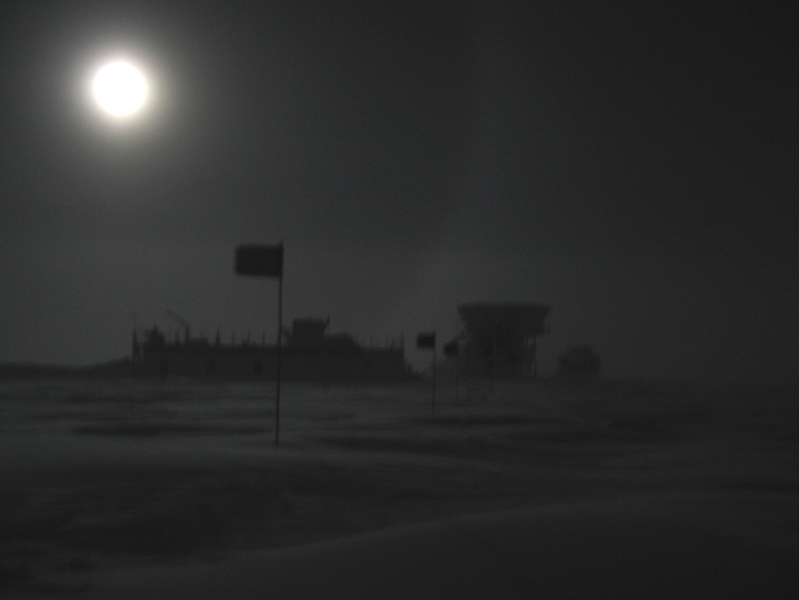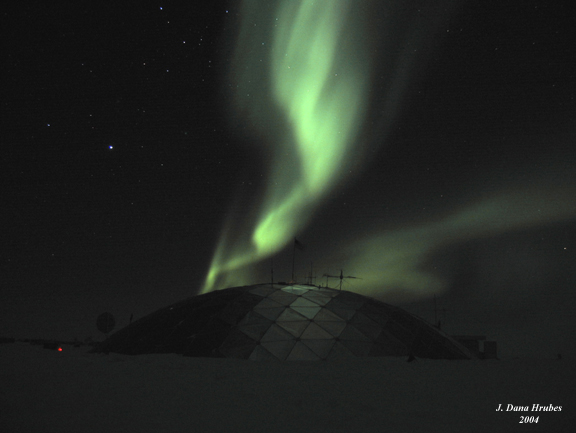
The full moon illuminating the flagline and the dark sector. The moon makes its appearance 14 days out of every 28 days
The polar plateau is very dark when the moon isn't present.

The
full moon illuminating the flagline and the dark sector. The moon makes
its appearance 14 days out of every 28 days
The polar plateau is very dark when the moon isn't present.
May at the Pole - beautiful
skies and eternal darkness
With
the end of astronomical twilight, May is the first full month of
complete darkness. where is the
sun now? The moon was up for two weeks
early in the month and
it as down for the last two weeks resulting in a much more difficult
walk. One advantage of the lack of moonlight, however, is that
the auroras are much more spectacular when it is totally dark. new
elevated station under a full moon
As
the winter progresses, the snow drifting and sastrugi become more and
more of a problem when walking my 2-1/2 miles each day to visit my
project sites. Sastrugi are wind blown formations in the snow
cover that can get very big and quite hard packed and are
randomly
located throughout the antarctic plateau. They are formed when a snow
drift is eroded or carved out by blowing ice crystals. Away from the
pole where it
is even
windier, I have heard they can get more than 6 feet tall. Here they
only
get a
few feet high, just right to trip on and fall on your red nose. They
get worse
in the winter because there is little sublimation of the snow at that
time and
they are good for tripping. That is why my knees are often
sore.
sastrugi
1
sastrugi 2
(sastrugi photos by Kevin Dupuy)
I usually don't use my headlamp when walking to a
site, because you can actually see better when you let your eyes adjust
to the darkness. When asked how it is to walk to the sites each day, I
answer, "It is like walking blindfolded through a field of bowling
balls wearing many layers of stiff extreme cold weather clothing and a
backpack at -96 F
with the wind in your face on the surface of Mars". On those occasions
when the moon is up and full and the winds are low and it is about -90
F or so, it can be extremely enjoyable, because you can see where you
are going and the wind isn't trying to frostnip every tiny portion of
exposed skin. I rarely wear goggles, because they frost up very easily
at these extreme temperatures. I just have my head covered with a
windstopper balaclava with a neck gaiter pulled up right under my eyes
and my knit insulated hat pulled down right over my eyes so I just have
a tiny slit to look out of. When it is windy and you are face into the
wind you usually still have perpetual frostbite on the bridge on your
nose, but for the most part that little bit of exposed skin on the
nose, cheeks and eyes are protected my a blanket of your warm
exhalation. viewing
life through the fleece
One of the buildings, the VLF beacon transmitter
building that is almost a mile off station has a severe snow drifting
problem right where the door is, so quite a bit of digging has been
required upon each daily visit, particularly when it is very
windy. The VLF beacon, a Stanford University project, transmits a
sine wave at 19.4 KHz and is
received at stations in Antarctica such as Palmer and McMurdo stations.
The received signal is compared to the transmitted signal and the
difference tells us quite a bit about the behavior of the lower
ionosphere, specifically electron precipitation. I have jokingly
given the station a call sign of "KNPX" , NPX being the designator for
South Pole.
VLF building door drift door
open with inside red light entering
the cold room of the building entering
the warm room through the freezer door VLF
transmitter transmitter power
source-batteries/inverters
On the other side of the station, over a mile from
the VLF beacon is the SETI telescope, a project of the Search for
Extraterrestrial Intelligence Institute (associated with NASA/AMES) and
University of New South Wales, Australia. Here we are searching for new
planets around other stars in our galaxy. Here we view large
numbers of stars simultaneously watching for specific periodic changes
in brightness. The objective of this particular search is to discover
very large planets close to its parent star resulting in short period
orbits so that we can observe these orbits within the 3 to 4 month
viewing window of eternal darkness at the South Pole.
inside the SETI/AASTO building
next to the telescope tower troubleshooting the
telescope mount controller soldering circuit boards

The auroras were again spectacular this
month. meteorology
department daily advisory
aurora-1
aurora-2
aurora-3 aurora-4
aurora-5
aurora-6
aurora-7
And finally we (the winter band) performed again this
month. Our name was the "Dana Hrubes Comeback Project" (not my idea)
since I hadn't played drums in a rock group for 33 years until this
year. This time the construction crew set up a scaffold for my drum set
to raise me up a couple of feet and our lead guitar player, Kevin,
built some great lighting for us. the band
me on my new platform
the band lighting
drums
NEXT MONTH:
Mid-Winter.... June 21.....
A Real-Time Photo of South Pole Station as Seen from the ARO Building (live when satellite is up)
A Comprehensive
South Pole Web Site by Bill Spindler
Winterover Web Pages
(Bill Spindler's List)
SOUTH
POLE 2003-2004 HOME PAGE